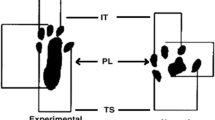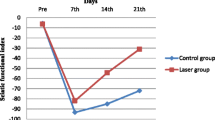Abstract
The objective of this study was to evaluate three energy densities of low-level laser therapy (LLLT, GaAlAs, 780 nm, 40 mW, 0.04 cm2) for the treatment of lesions to peripheral nerves using the sciatic nerve of rats injured via crushing model (15 kgf, 5.2 MPa). Thirty Wistar rats (♂, 200–250 g) were divided into five groups (n = 6): C—control, not injured, and irradiated; L0—injured nerve without irradiation; L4—injured nerve irradiated with LLLT 4 J/cm2 (0.16 J); L10—injured nerve irradiated with LLLT 10 J/cm2 (0.4 J); and L50—injured nerve irradiated with LLLT 50 J/cm2 (2 J). The animals were sacrificed 2 weeks after the injury via perfusion with glutaraldehyde (2.5%, 0.1 M sodium cacodylate buffer). The nerve tissue was embedded in historesin, cut (3 μm), mounted on slides, and stained (Sudan black and neutral red). The morphological and quantitative analysis (myelin and blood capillary densities) and morphometric parameters (maximum and minimum diameters of nerve fibers, axon diameter, G-ratio, myelin sheath thickness) were assessed using the ImageJ software. ANOVA (parametric) or Kruskal-Wallis (nonparametric) tests were used for the statistical analysis. Groups L0, L4, L10, and L50 exhibited diminished values of all the quantitative and morphometric parameters in comparison to the control group. The morphological, quantitative, and morphometric data revealed improvement after injury in groups L4, L10, and L50 (irradiated groups) compared to the injured-only group (L0); the best results, in general, were observed for the L10 group after 15 days of nerve injury.




Similar content being viewed by others
References
Lundborg G (1987) Nerve regeneration and repair. A review. Acta orthop scand 58:145–169
Evans GR (2001) Peripheral nerve injury: a review and approach to tissue engineered constructs. Anat rec 263:396–404
Raimondo S, Fornaro M, Tos P et al (2011) Perspectives in regeneration and tissue engineering of peripheral nerves. Ann anat 193:334–340
Martínez De Albornoz P, Delgado PJ, Forriol F, Maffulli N (2011) Non-surgical therapies for peripheral nerve injury. Br med bull 100:73–100
Shen CC, Yang YC, Liu BS (2011) Large-area irradiated low-level laser effect in a biodegradable nerve guide conduit on neural regeneration of peripheral nerve injury in rats. Injury 42:803–813
Dubový P (2011) Wallerian degeneration and peripheral nerve conditions for both axonal regeneration and neuropathic pain induction. Ann anat 193:267–275
Rovak JM, Mungara AK, Aydin MA et al (2004) Effects of vascular endothelial growth factor on nerve regeneration in acellular nerve grafts. J reconstr microsurg 20:53–58
Morries LD, Cassano P, Henderson TA (2015) Treatments for traumatic brain injury with emphasis on transcranial near-infrared laser phototherapy. Neuropsychiatr dis treat 11:2159–2175
Hashmi JT, Huang YY, Osmani BZ et al (2010) Role of low-level laser therapy in neurorehabilitation. PM R 12:s292–s305
Gomes LE, Dalmarco EM, André ES (2012) The brain-derived neurotrophic factor, nerve growth factor, neurotrophin-3, and induced nitric oxide synthase expressions after low-level laser therapy in an axonotmesis experimental model. Photomed laser surg 30:642–647
Yazdani SO, Golestaneh AF, Shafiee A et al (2012) Effects of low level laser therapy on proliferation and neurotrophic factor gene expression of human Schwann cells in vitro. J photochem photobiol b 107:9–13
Belchior AC, Dos Reis FA, Nicolau RA et al (2009) Influence of laser (660 nm) on functional recovery of the sciatic nerve in rats following crushing lesion. Lasers med sci 24:893–899
Dos Reis FA, Belchior AC, De Carvalho PT et al (2009) Effect of laser therapy (660 nm) on recovery of the sciatic nerve in rats after injury through neurotmesis followed by epineural anastomosis. Lasers med sci 24:741–747
Barbosa RI, Marcolino AM, De Jesus Guirro RR et al (2010) Comparative effects of wavelengths of low-power laser in regeneration of sciatic nerve in rats following crushing lesion. Lasers med sci 25:423–430
Gigo-Benato D, Russo TL, Tanaka EH et al (2010) Effects of 660 and 780 nm low-level laser therapy on neuromuscular recovery after crush injury in rat sciatic nerve. Lasers surg med 42:673–862
Medalha CC, Di Gangi GC, Barbosa CB et al (2012) Low-level laser therapy improves repair following complete resection of the sciatic nerve in rats. Lasers med sci 27:629–635
Marcolino AM, Barbosa RI, Das Neves LM, Mazzer N, De Jesus Guirro RR, De Cássia Registro Fonseca M (2013) Assessment of functional recovery of sciatic nerve in rats submitted to low-level laser therapy with different fluences. An experimental study: laser in functional recovery in rats. J hand microsurg 5:49–53
Sene GA, Souza FF, Fazan VS, E Barbieri CH (2013) Effects of laser therapy in peripheral nerve regeneration. Acta ortop bras 21:266–270
Wang CZ, Chen YJ, Wang YH, Yeh ML, Huang MH, Ho ML, Liang JI, Chen CH (2014) Low-level laser irradiation improves functional recovery and nerve regeneration in sciatic nerve crush rat injury model. Plos one 9:e103348
Takhtfooladi MA, Jahanbakhsh F, Takhtfooladi HA, Yousefi K, Allahverdi A (2015) Effect of low-level laser therapy (685 nm, 3 J/cm2) on functional recovery of the sciatic nerve in rats following crushing lesion. Lasers med sci 30:1047–1052
Dias FJ, Issa JPM, Coutinho-Netto J et al (2015) Morphometric and high resolution scanning electron microscopy analysis of low-level laser therapy and latex protein (Hevea brasiliensis) administration following a crush injury of the sciatic nerve in rats. J neurol sci 349:129–137
Muniz KL, Dias FJ, Coutinho-Netto J et al (2015) Properties of the tibialis anterior muscle after treatment with laser therapy and natural latex protein following sciatic nerve crush. Muscle nerve 52:869–875
Schiaveto De Souza A, Da Silva CA, Del Bel EA (2004) Methodological evaluation to analyze functional recovery after sciatic nerve injury. J neurotrauma 21:627–635
Behmer OA, Tolosa EMC, Freitas Neto AG (1976) Manual of techniques for normal and pathological histology [Portuguese] 1 ed. EDART, Editora da Universidade de São Paulo, São Paulo
Arino H, Brandt J, Dahlin LB (2008) Implantation of Schwann cells in rat tendon autografts as a model for peripheral nerve repair: long term effects on functional recovery. Scand j plast reconstr surg hand surg 42:281–285
Chomiak T, Hu B (2009) What is the optimal value of the g-ratio for myelinated fibers in the rat CNS? A theoretical approach. Plos one 4:e7754
Santos AP, Suaid CA, Xavier M, Yamane F (2012) Functional and morphometric differences between the early and delayed use of phototherapy in crushed median nerves of rats. Lasers med sci 27:479–486
Holm S (1979) A simple sequentially rejective multiple test procedure. Scand j stat 6:65–70
Rochkind S, Leider-Trejo L, Nissan M et al (2007) Efficacy of 780-nm laser phototherapy on peripheral nerve regeneration after neurotube reconstruction procedure (double-blind randomized study). Photomed laser surg 25:137–143
Sousa FF, Ribeiro TL, Fazan VP, Barbieri CH (2013) Lack of effectiveness of laser therapy applied to the nerve course and the correspondent medullary roots. Acta ortop bras 21:92–97
Wood MD, Kemp SW, Weber C, Borschel GH, Gordon T (2011) Outcome measures of peripheral nerve regeneration. Ann anat 193:321–333
Mendonça RJ, Maurício VB, Teixeira Lde B, Lachat JJ, Coutinho-Netto J (2010) Increased vascular permeability, angiogenesis and wound healing induced by the serum of natural latex of the rubber tree Hevea brasiliensis. Phytother res 24:764–768
de Campos D, Heck L, Jotz GP (2014) Degree of myelination (G-ratio) of the human recurrent laryngeal nerve. Eur arch otorhinolaryngol 271:1277–1281
Rushton WA (1951) A theory of the effects of fibre size in medullated nerve. J physiol 115:101–122
Raimondo S, Fornaro M, Di Scipio F et al (2009) Chapter 5: methods and protocols in peripheral nerve regeneration experimental research: part II-morphological techniques. Int rev neurobiol 87:81–103
Byrnes KR, Waynant RW, Ilev IK et al (2005) Light promotes regeneration and functional recovery and alters the immune response after spinal cord injury. Lasers surg med 36:171–185
Acknowledgments
The authors are grateful to FAPESP (processes no. 2014/07254-3 and 2014/22360-1) for their financial support of this study.
Author information
Authors and Affiliations
Corresponding author
Ethics declarations
Ethical approval
The project was approved by the Ethics Committee on Animal Use of Ribeirão Preto Dental School, University of São Paulo (Protocol. 2014.1162.58.1) and followed the international laws on animal experimentation, performed according to the Helsinki Declaration.
Conflict of interest
The authors declare that they have no conflict of interest.
Role of funding source
The entire study was funded by FAPESP (São Paulo Research Foundation), a public foundation, funded by the taxpayer in the State of São Paulo (Brazil), with the mission to support research projects in higher education and research institutions, in all fields of knowledge. FAPESP is not linked to any company and/or product cited in this study.
Rights and permissions
About this article
Cite this article
Ziago, E.K.M., Fazan, V.P.S., Iyomasa, M.M. et al. Analysis of the variation in low-level laser energy density on the crushed sciatic nerves of rats: a morphological, quantitative, and morphometric study. Lasers Med Sci 32, 369–378 (2017). https://doi.org/10.1007/s10103-016-2126-1
Received:
Accepted:
Published:
Issue Date:
DOI: https://doi.org/10.1007/s10103-016-2126-1




